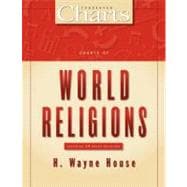
Note: Supplemental materials are not guaranteed with Rental or Used book purchases.
Purchase Benefits
What is included with this book?
| Preface | p. 11 |
| Acknowledgments | p. 13 |
| Prolegomena to World Religions | |
| What Is Religion? | |
| Four Functional Modes of Religion | |
| Three Basic Views on Faith and Reason | |
| Terms Relating to Religion | |
| Six Dimensions of Religion | |
| Do All Religions Lead to God? | |
| Comparison of Foundational Religious Worldviews | |
| Comparison of World Religions | |
| Major World Religions in Order of Founding | |
| Comparison of Beliefs Among Religions | |
| Holy Books of World Religions | |
| Ancient Mediterranean Religions | |
| Religions of the Ancient Mediterranean World | |
| Ancient Near Eastern Deities (Excluding Egypt) | |
| Egyptian Paganism | |
| Gods of the Egyptian Pantheon | |
| Greek Paganism | |
| Roman Paganism | |
| Graeco-Roman Deities | |
| Western Religions | |
| Historical Relationships of Western Religions | |
| Comparison of Western Religions Judaism | |
| Timeline of Judaism | |
| Judaism | |
| Comparison of Beliefs within Judaism | |
| Orthodox Judaism | |
| Conservative Judaism | |
| Reform Judaism | |
| Hasidic Judaism | |
| Jewish Scriptures According to Rabbinic Tradition | |
| Jewish Holy Days | |
| The Jewish Calendar | |
| The Jewish Covenants Christianity | |
| Timeline of Christianity | |
| Christianity | |
| Comparison of Beliefs within Christianity | |
| Roman Catholicism | |
| Eastern Orthodoxy | |
| Liberal Protestantism | |
| Evangelical Protestantism | |
| Fundamentalist Protestantism | |
| Pentecostal-Charismatic Protestantism | |
| Christian Creeds and Councils | |
| Christian Holy Days | |
| Christian Scriptures Islam | |
| Timeline of Islam | |
| Islam | |
| Comparison of Beliefs within Islam | |
| Sunni Islam | |
| Shi'ite Islam | |
| Sufi Islam | |
| Nation of Islam | |
| Islamic Calendar and Holy Days Baha'i | |
| Timeline of Baha'i | |
| Baha'i Secular Humanism | |
| Timeline of Secular Humanism | |
| Secular Humanism | |
| Eastern Religions | |
| Historical Relationships of Eastern Religions | |
| Comparison of Eastern Religions Hinduism | |
| Timeline of Hinduism | |
| Hinduism | |
| Comparison of Beliefs within Hinduism | |
| Brahmanism | |
| Advaita Vedanta | |
| Bhakti | |
| Self-Realization Fellowship, Appendix on Transcendental Meditation | |
| Ananda Marga Yoga Society | |
| Hare Krishna (ISKCON) Buddhism | |
| Timeline of Buddhism | |
| Buddhism | |
| Comparison of Beliefs within Buddhism | |
| Mahayana Buddhism, Appendix on Pure Land Buddhism | |
| Theravada Buddhism | |
| Vajrayana Buddhism | |
| Zen Buddhism | |
| Nichiren Shoshu Buddhism Taoism | |
| Timeline of Taoism | |
| Taoism, Appendix on Religious Taoism Jainism | |
| Timeline of Jainism | |
| Jainism Zoroastrianism | |
| Timeline of Zoroastrianism | |
| Zoroastrianism Shintoism | |
| Timeline of Shinto | |
| Shinto Confucianism | |
| Timeline of Confucianism | |
| Confucianism Sikhism | |
| Timeline of Sikhism | |
| Sikhism | |
| Indigenous Religions | |
| Historical Relationships of Indigenous Religions | |
| Comparison of Indigenous Religions African | |
| Timeline of African Traditional Religion | |
| African Traditional Religion Caribbean | |
| Caribbean Religions | |
| Comparison of Caribbean Religions | |
| Timeline of Rastafari | |
| Rastafari | |
| Timeline of Santeria and Palo Mayombe | |
| Santeria, Appendix on Palo Mayombe | |
| Timeline of Umbanda and Candombl+¼ | |
| Umbanda, Appendix on Candombl+¼ | |
| Timeline of Voudon (Voodoo) | |
| Voudon (Voodoo) Native American | |
| Timeline of Native American Religion | |
| Native American Religion | |
| Glossary | p. 316 |
| Sources | p. 322 |
| Recommended Reading List | p. 336 |
| Table of Contents provided by Publisher. All Rights Reserved. |
The New copy of this book will include any supplemental materials advertised. Please check the title of the book to determine if it should include any access cards, study guides, lab manuals, CDs, etc.
The Used, Rental and eBook copies of this book are not guaranteed to include any supplemental materials. Typically, only the book itself is included. This is true even if the title states it includes any access cards, study guides, lab manuals, CDs, etc.
Excerpted from Zond Charts-world Religions by H. Wayne House, H. W. House
All rights reserved by the original copyright owners. Excerpts are provided for display purposes only and may not be reproduced, reprinted or distributed without the written permission of the publisher.